Creating your auction site can be an exciting venture, especially with the right tools. WordPress, being a versatile content management system, allows you to set up a fully functional auction website with ease. In this guide, we will go through the necessary steps to build your own auction site using WordPress.
Step 1: Setting Up Your Hosting and Domain
Before diving into the design and functionality, you’ll need to choose a reliable hosting provider and register a domain name. For the best performance, consider WafaTech NextGen WordPress Hosting which you can learn more about here.
Choosing a domain that reflects your auction site’s purpose is crucial for branding and SEO.
Step 2: Installing WordPress
Most hosting providers, including WafaTech, offer one-click WordPress installations. Once you’ve registered your domain and set up your hosting account, log in to your hosting dashboard and use the one-click installer for WordPress.
For detailed instructions on manual installations, you can refer to the official WordPress documentation.
Step 3: Choosing the Right Auction Plugin
To turn your WordPress site into an auction platform, you’ll need a specialized plugin. Some popular auction plugins to consider include:
- WP Auction: A simple and user-friendly plugin for creating auctions.
- Ultimate Auction: Offers extensive features including bidding systems, user management, and payment options.
- WooCommerce Simple Auctions: If you already have WooCommerce set up, this could be your go-to solution for auction functions.
You can browse and install these plugins directly from your WordPress dashboard under Plugins -> Add New.
Step 4: Configuring Your Auction Plugin
Once you’ve installed your preferred auction plugin, it’s time to configure it. Each plugin will have its own settings for customizing auctions. Common features to set up include:
- Auction Duration: Determine how long each auction will run.
- Bidding Increment: Specify the minimum bid increase.
- Reserve Price: Set a minimum price for the item to be sold.
Refer to your plugin’s documentation for specific configurations. Each plugin generally has its own section within the WordPress admin area.
Step 5: Designing Your Auction Site
Your website’s design plays a significant role in user experience. WordPress offers a plethora of themes tailored for auction sites. Look for responsive themes that enhance usability on both desktops and mobile devices.
Some popular theme options include:
- Auction Theme: A dedicated auction theme with customization options.
- Bidder: A user-friendly theme specializing in auction functionalities.
You can find many of these themes in the WordPress Theme Directory.
Step 6: Adding Products to Auction
After setting up your auction plugin, it’s time to add products. This process varies based on the plugin you’ve chosen but generally involves filling out information such as:
- Product name
- Description
- Starting bid price
- Auction duration
- Images of the product
Keep your descriptions clear and engaging to attract bidders.
Step 7: Payment Gateway Setup
To process payments efficiently, set up a secure payment gateway. Popular options include PayPal, Stripe, and WooCommerce Payments. Each payment option will often have a dedicated plugin or support through your auction plugin.
Refer to the official WooCommerce documentation for setting up payment gateways if you’ve chosen WooCommerce.
Step 8: Marketing Your Auction Site
Once your auction site is live, use various marketing techniques to attract bidders:
- SEO Optimization: Utilize SEO tools and plugins (like Yoast SEO) to improve your website’s visibility.
- Social Media: Promote your auctions through platforms like Facebook, Instagram, and Twitter.
- Email Newsletters: Engage your audience by sending newsletters featuring upcoming auctions.
Step 9: Monitor and Optimize Performance
After launching, don’t forget to monitor your auction site’s performance. Use tools like Google Analytics to track visitors and understand user behavior.
Regularly update WordPress, themes, and plugins to ensure your site runs smoothly and securely.
Conclusion
Building an auction site with WordPress is not only feasible but can also be quite rewarding with the right approach. Following the steps outlined above will help you create a platform that meets your needs and those of your users.
Call to Action
Ready to take your auction business to the next level? Explore WafaTech NextGen WordPress Hosting for the best performance and support tailored specifically for your needs. For more details, visit here.
For more resources, visit the official WordPress documentation to enhance your understanding and make the most out of your WordPress auction site!





